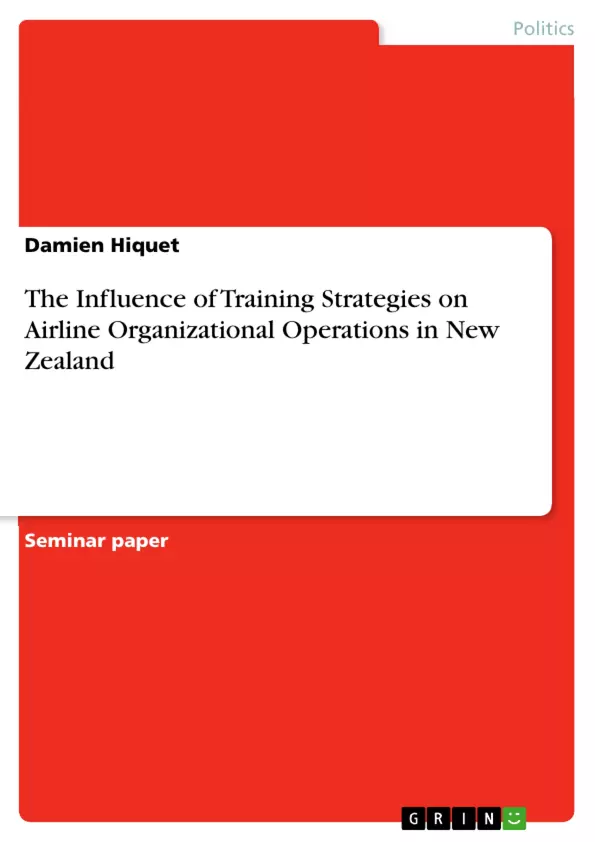This paper addresses the impact of training strategies on airline organizational operations in New Zealand. Airline operations involve numerous departments aiming at a hundred percent on-time performance (OTP) for each flight departure with safety as a non-negotiable condition. Thus, safety training is at the heart of operations and has been incorporated in multiple management systems supported by different departments such as Safety Management System (SMS), Quality Management System (QMS), Security Management System (SeMS), Flight Operations Quality Assurance (FOQA), Environmental Management System (EMS) and Occupational Health Safety Management System (OHSMS). Therefore, the company has adopted an Integrated Airline Safety Management System (IASMS) which outlines the core policies and processes that make up the company group SMS.
Inhaltsverzeichnis (Table of Contents)
- 1. Introduction: Description of the Organisational Operation
- 2. The objectives
- 2.1. Learning Management System (LMS)
- 2.2 On-the-job training (OJT)
- 3. Targeted injuries and illnesses
- 4. Comparison and contrast of strategies
- 4.1 SWOT analysis of OJT
- 4.2 SWOT analysis of LMS
- 4.3 Instructional Systems Design (ISD)
- 5. Conclusion: the influence of each strategies on the organisational operation
Zielsetzung und Themenschwerpunkte (Objectives and Key Themes)
This document aims to analyze the influence of various training strategies on an organization's operational effectiveness, with a specific focus on a company operating within the airline industry. The document explores the impact of different training approaches on safety culture, compliance, and overall organizational performance.
- Training Strategies for Safety Promotion
- Impact of Training on Organisational Safety Culture
- Comparison of Learning Management Systems (LMS) and On-the-Job Training (OJT)
- Importance of Instructional Systems Design (ISD) for Effective Training
- Legal and Regulatory Considerations for Training in the Aviation Industry
Zusammenfassung der Kapitel (Chapter Summaries)
The first chapter of the document provides an overview of the organizational operation within the airline industry, highlighting the interconnected nature of various departments and the crucial role of safety training in ensuring operational success. It emphasizes the integration of safety training within existing management systems such as SMS, QMS, and OHSMS.
The second chapter delves into the specific objectives of training within an SMS-based organization. It underscores the importance of promoting safety by preventing injuries and damages while cultivating a robust safety culture. The chapter discusses the legal requirements and duty of care enforced by New Zealand's Health and Safety at Work Act 2015.
The third chapter focuses on the targeted injuries and illnesses prevalent within the aviation industry. It highlights the need for specific training programs to address these risks and ensure the safety of both employees and passengers.
The fourth chapter compares and contrasts different training strategies, including On-the-Job Training (OJT) and Learning Management Systems (LMS). It analyzes the strengths and weaknesses of each approach using a SWOT analysis and examines the role of Instructional Systems Design (ISD) in enhancing training effectiveness.
Schlüsselwörter (Keywords)
The document centers on the key concepts of training strategies, organizational safety culture, airline operations, safety management systems (SMS), learning management systems (LMS), on-the-job training (OJT), instructional systems design (ISD), and legal compliance in the aviation industry. These terms encapsulate the core themes and focus of the document, highlighting the critical relationship between training and operational success within the airline industry.
- Quote paper
- Damien Hiquet (Author), 2021, The Influence of Training Strategies on Airline Organizational Operations in New Zealand, Munich, GRIN Verlag, https://www.grin.com/document/1151310



